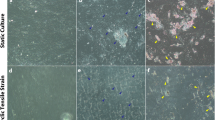Abstract
Primary cilia are sensory organelles that have been shown to play a critical role in lineage commitment. It was our hypothesis that the primary cilium is necessary for chemically induced differentiation of human mesenchymal stem cells (MSC). To investigate this, polaris siRNA was used to inhibit the primary cilia and the mRNA levels of transcription factors Runx2, PPARγ were measured by RT PCR as markers of osteogenic, adipogenic and chondrogenic differentiation, respectively. MSCs with inhibited primary cilia had significantly decreased basal mRNA expression levels of all three lineages specific transcription factors indicating that primary cilia are critical in multiple differentiation pathways. Furthermore, to determine if primary cilia play a role in the differentiation potential of MSCs, progenitor cells transfected with either scrambled or polaris siRNA were cultured in osteo-inductive, chondro-inductive, or adipo-inductive media and lineage commitment was ascertained. Interestingly, within 24 h of culture, cells transfected with polaris siRNA in both osteogenic and adipogenic media lost adhesion and released from the slides; however MSCs in chondrogenic media as well as cells transfected with scrambled siRNA did not. These results suggest that the primary cilium is necessary for the normal progression of chemically induced osteogenic and adipogenic differentiation. As a control, the experiment was repeated with NIH3T3 fibroblasts and none of the effects of inhibited primary cilia were observed indicating that the loss of adhesion may be specific to MSCs. Furthermore after biochemically inducing the cells to differentiate, polaris knockdown resulted in abrogation of both Runx2 and PPARγ mRNA while SOX9 mRNA expression was significantly lower. These results suggest that primary cilia play an essential role not only in the initiation of both osteogenic and adipogenic differentiation, but also in maintaining the phenotype of differentiated cells. Interestingly, chondrogenic differentiation appeared less dependent on a functional primary cilium.





Similar content being viewed by others
References
Arnsdorf, E. J., P. Tummala, R. Y. Kwon, and C. R. Jacobs. Mechanically induced osteogenic differentiation—the role of RhoA, ROCKII and cytoskeletal dynamics. J. Cell Sci. 122(Pt 4):546–553, 2009; (Epub 2009 Jan 27).
Badano, J. L., N. Mitsuma, P. L. Beales, and N. Katsanis. The ciliopathies: an emerging class of human genetic disorders. Annu. Rev. Genomics Hum. Genet. 7:125–148, 2006.
Bryan, B. A., D. C. Mitchell, L. Zhao, W. Ma, L. J. Stafford, B. B. Teng, and M. Liu. Modulation of muscle regeneration, myogenesis, and adipogenesis by the Rho family guanine nucleotide exchange factor GEFT. Mol. Cell. Biol. 25(24):11089–11101, 2005.
Christensen, S. T., and C. M. Ott. Cell signaling. A ciliary signaling switch. Science 317(5836):330–331, 2007.
Christensen, S. T., L. B. Pedersen, L. Schneider, and P. Satir. Sensory cilia and integration of signal transduction in human health and disease. Traffic 8(2):97–109, 2007.
Corbit, K. C., A. E. Shyer, W. E. Dowdle, J. Gaulden, V. Singla, M. H. Chen, P. T. Chuang, and J. F. Reiter. Kif3a constrains beta-catenin-dependent Wnt signalling through dual ciliary and non-ciliary mechanisms. Nat. Cell Biol. 10(1):70–76, 2008; (Epub 2007 Dec 16. Erratum in: Nat. Cell Biol. 2008 Apr;10(4):497).
de Crombrugghe, B., V. Lefebvre, R. R. Behringer, W. Bi, S. Murakami, and W. Huang. Transcriptional mechanisms of chondrocyte differentiation. Matrix Biol. 19(5):389–394, 2000.
Komori, T. Mechanism of transcriptional regulation by Runx2 in osteoblasts. Clin. Calcium 16(5):801–807, 2006.
McBeath, R., D. M. Pirone, C. M. Nelson, K. Bhadriraju, and C. S. Chen. Cell shape, cytoskeletal tension, and RhoA regulate stem cell lineage commitment. Dev. Cell 6(4):483–495, 2004.
Ozawa, K., K. Sato, I. Oh, K. Ozaki, R. Uchibori, Y. Obara, Y. Kikuchi, T. Ito, T. Okada, M. Urabe, H. Mizukami, and A. Kume. Cell and gene therapy using mesenchymal stem cells (MSCs). J. Autoimmun. 30(3):121–127, 2008; (Epub 2008 Jan 31).
Pan, J., Y. You, T. Huang, and S. L. Brody. RhoA-mediated apical actin enrichment is required for ciliogenesis and promoted by Foxj1. J. Cell Sci. 120(Pt 11):1868–1876, 2007; (Epub 2007 May 8).
Pittenger, M. F., A. M. Mackay, S. C. Beck, R. K. Jaiswal, R. Douglas, J. D. Mosca, et al. Multilineage potential of adult human mesenchymal stem cells. Science 284:143–147, 1999.
Rohatgi, R., L. Milenkovic, and M. P. Scott. Patched1 regulates hedgehog signaling at the primary cilium. Science 317(5836):372–376, 2007.
Satir, P., and S. T. Christensen. Structure and function of mammalian cilia. Histochem. Cell Biol. 129(6):687–693, 2008; (Epub 2008 Mar 26).
Singla, V., and J. F. Reiter. The primary cilium as the cell’s antenna: signaling at a sensory organelle. Science 313(5787):629–633, 2006.
Torres, V. E., and P. C. Harris. Mechanisms of disease: autosomal dominant and recessive polycystic kidney diseases. Nat. Clin. Pract. Nephrol. 2(1):40–55, 2006.
Wheatley, D. N., A. M. Wang, and G. E. Strugnell. Expression of primary cilia in mammalian cells. Cell Biol. Int. 20(1):73–81, 1996.
Woods, A., and F. Beier. RhoA/ROCK signaling regulates chondrogenesis in a context-dependent manner. J. Biol. Chem. 281(19):13134–13140, 2006; (Epub 2006 Mar 24).
Woods, A., G. Wang, H. Dupuis, Z. Shao, and F. Beier. Rac1 signaling stimulates N-cadherin expression, mesenchymal condensation, and chondrogenesis. J. Biol. Chem. 282(32):23500–23508, 2007; (Epub 2007 Jun 14).
Yoder, B. K. Role of primary cilia in the pathogenesis of polycystic kidney disease. J. Am. Soc. Nephrol. 18(5):1381–1388, 2007; (Epub 2007 Apr 11).
Acknowledgments
This work was funded by National Institute of Health Grants AR45989 and AR54156 and the United States Department of Veterans Affairs.
Author information
Authors and Affiliations
Corresponding author
Additional information
Associate Editor Lance Kam and Partha Roy oversaw the review of this article.
Rights and permissions
About this article
Cite this article
Tummala, P., Arnsdorf, E.J. & Jacobs, C.R. The Role of Primary Cilia in Mesenchymal Stem Cell Differentiation: A Pivotal Switch in Guiding Lineage Commitment. Cel. Mol. Bioeng. 3, 207–212 (2010). https://doi.org/10.1007/s12195-010-0127-x
Received:
Accepted:
Published:
Issue Date:
DOI: https://doi.org/10.1007/s12195-010-0127-x




